Last updated on May 18, 2024
If you have an antique pocket watch, it is essential for peace of mind, to also own and use a pocket watch chain. It secures the watch and as an accessory adds an element of elegance to an outfit. There is no need to own a chain for each antique pocket watch in your collection, they are detachable and can be shared amongst your watches. In fact, because many pocket watch chains are made from precious metals, such as silver, in many cases they can cost more to buy than many antique pocket watches. In this post, we will explore the history of the pocket watch chain and look at the most common types available. The most famous, of course, are the Albert watch chains.
Watch chains
The traditional function of the watch chain was to simply ensure the security of the watch from which it hung. Most people think of this as the ‘pocket watch’ which emerged in the 17th Century. However, the watch chain arrived prior to the pocket watch. In 16th-century Europe, they were used to secure larger ‘clock-watches’. Typically, the watch chain was worn around the neck, meaning the ‘clock watch’ was worn as a pendant. These early clock watches were not worn to tell the time. The accuracy of their primitive movements was so poor, with errors of perhaps several hours per day, that they were practically useless as timepieces. They were carried more as an item of jewellery that acted as a status symbol for the nobility.
Pocket watches
Watch styles changed in the 17th century. In 1675 when Charles II of England introduced waistcoats men began to wear watches in pockets instead of as pendants. This was not just a result of changes in fashion, but as a means to protect the watch. At the time watches were notoriously prone to fouling from exposure to the elements. They could only reliably be kept safe from harm if carried securely in the pocket. To fit in pockets, their shape evolved into the typical pocket watch shape, rounded and flattened with no sharp edges.
The pocket watch’s primary accessory is the watch chain and no pocket watch should be worn without one. Apart from the aesthetic side of it, pocket watch chains have a functional purpose as well. The chain serves as a fob, that is, an item for grasping and retrieving the watch from a pocket. However, it also serves as a security device, and prevents the watch from falling and breaking on the ground, should it be dropped. The chain weight and link size are a matter of personal taste. Typically, a fine, thin chain is more suited to formal dress. Thick, durable chains are more suitable for day-to-day activities.
Albert chains
Although the watch chains had been worn since the 16th Century, the Albert watch chain was introduced much later. Albert watch chains are named after Prince Albert (1819-1861), who was consort to Queen Victoria (1837-1901). The chain would traditionally comprise of a T-bar on one end used to affix the chain to a vest buttonhole. The opposite end of the chain would be fitted with a swivel or a large spring-loaded bolt ring to attach a pocket watch. The watch would then be placed in a vest pocket with the chain exposed and often adorned with a decorative fob.
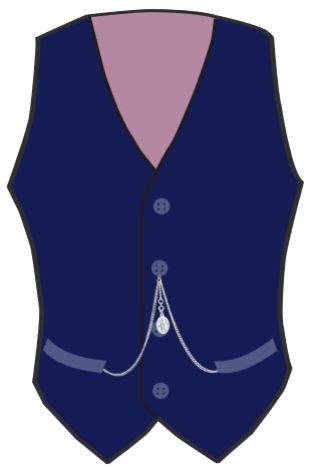
Traditionally, the Albert chain included a “drop”, with a small additional section of chain descending from the T-bar. This short length of chain terminated in some kind of ornament normally referred to as a “fob”. Historically, these were typically badges of affiliation of some form or another. The fob may be marked with the owner’s initials or perhaps a family, military, club, or university crests. Sometimes the fob was purely ornamental, perhaps with an elaborate design or coloured stone. Later Albert chains often dispensed with the drop.
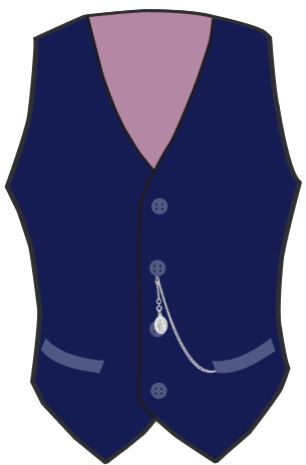
Double Alert chains
Prior to the 1850s all pocket watches were set and wound by keys. This meant the need to carry the key when wearing the watch, so both needed to be kept secure. The double Albert watch chain is characterised by having two equal lengths of chain attached to the T-bar. One chain was used to hold the pocket watch. The other was, traditionally, used to hold the watch key to wind the movement. However, after the 1850s it would seem that alternative accessories, such as a pocket knife, a cigar cutter or a vesta case would be carried in place of the key. This is because stem-wound watches became available from the 1850s and there was no longer the need to carry a key.
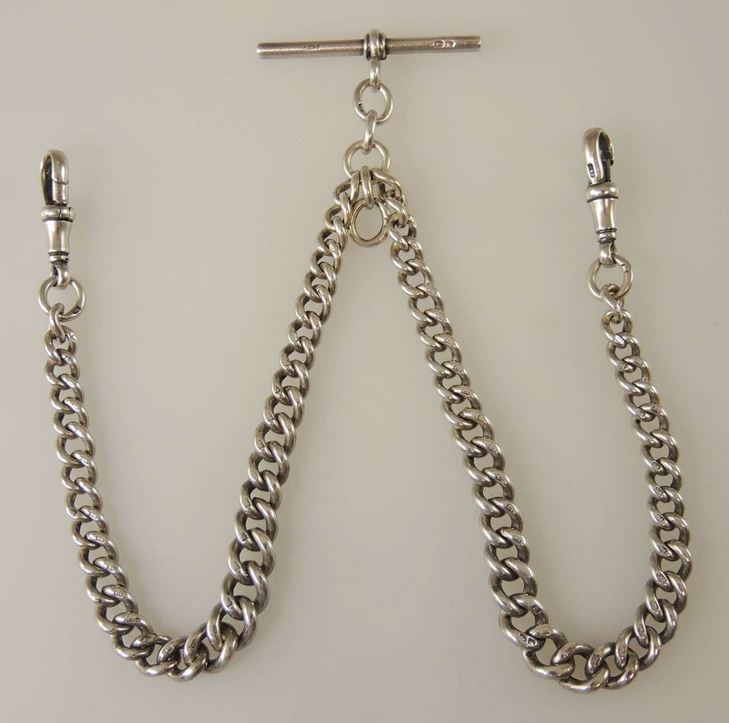
Single Albert watch chains
This style of single watch chain has a bar on one end, used to slot into a buttonhole of a waistcoat. The other end of the chain has a small swivel clasp that attaches to a pocket watch. The swivel clasp allows the wearer to rotate the watch and keep the chain from twisting. In addition to the chain that links the clasp and the T-bar, there is often another, smaller, chain that serves as a decorative drop. This can be used to display an ornamental fob or medallion.
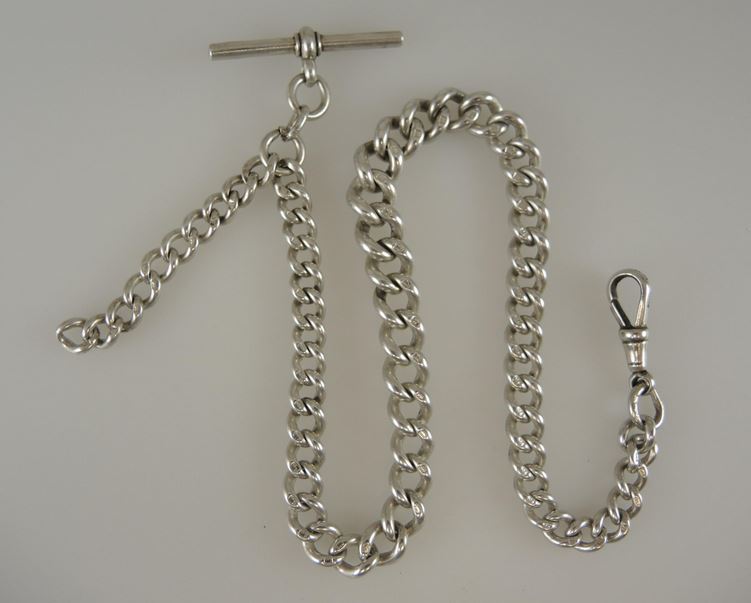
In the Victorian period, Albert watch chains were extremely popular, serving as a must-have accessory for any gentrified male. However, they declined in popularity with the rise of the wristwatch. However, the Albert watch chain remained a symbol of class and wealth. There are more modern options available for a more relaxed or casual look. These include bolt ring chains, belt clips, leather fobs and pouches.
Albertina watch chain
An Albertina chain is the name given to a watch chain worn by ladies during Victorian times. The Albertina chains were generally finer than the Albert chains and were often multi-stranded, with elaborate charms, tassels and fobs. The chains were finer because ladies’ watches tended to be much smaller and lighter than the heavy pocket watches worn by gentlemen. In the Victorian era, Albertina watch chains were often used as more than just a decorative watch chains. They were worn as pieces of jewellery and were often alternatively worn as necklaces or bracelets.
Related content
Pocket watch chains at Atlam Watches.
A list of additional posts regarding antique watches can be found on the Guides page.

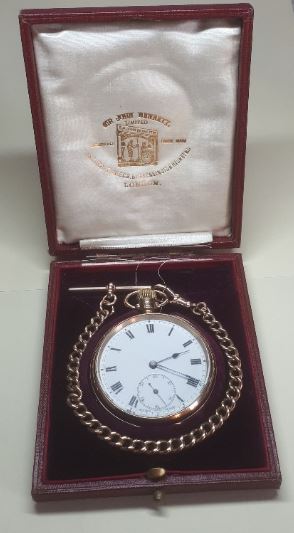
Hello
I’m reading your site, it’s very good, congratulations. I have a question. Isn’t the single Albert chain suitable for a key wind pocket watch? Only stem wind watch?
Regards:
Barnabás
Hi Barnabás, I’m glad you are enjoying the Time Worn Watches website. The single Albert watch chain is suitable for key wound watches, it just doesn’t have the extra chain that a double Albert has which allows you to attach the key. However, it does suit keyless watches best. I often wear key wound watches with a single Albert, but I just leave the key at home. Obviously, this doesn’t work if you are away from home. In this case, you would need to carry the key in a pocket or your wallet. Thanks for commenting, Jason